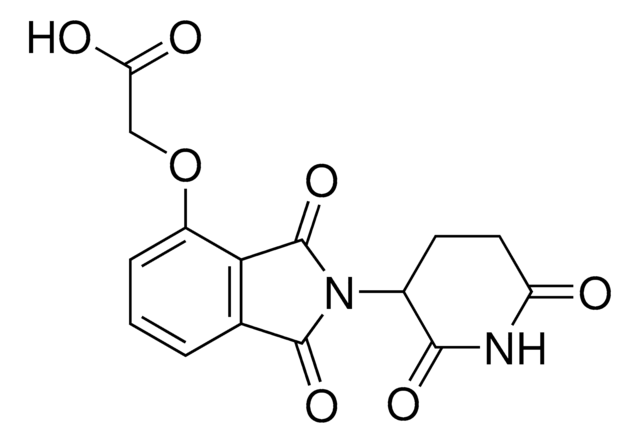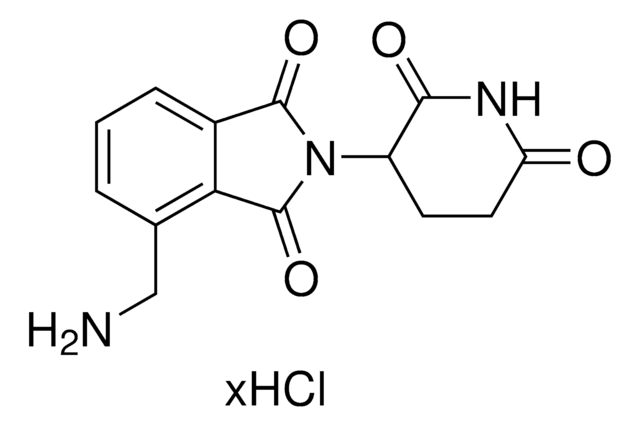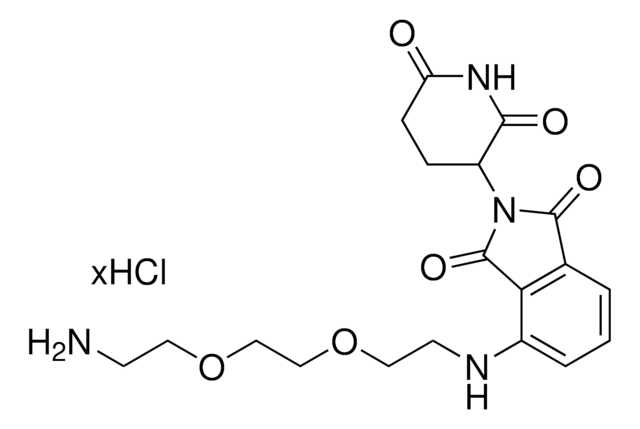936553
(S,R,S)-AHPC-acetamido-O-PEG4-C1-acid
≥95%
Sinônimo(s):
(S,R,S)-AHPC-acetamido-O-PEG4-C1-acid, (S)-19-[[(2S,4R)-4-Hydroxy-2-[[4-(4-methylthiazol-5-yl)benzyl]carbamoyl]pyrrolidin-1-yl]carbonyl]-20,20-dimethyl-17-oxo-3,6,9,12,15-pentaoxa-18-azahenicosanoic acid, L-Prolinamide, N-(16-carboxy-1-oxo-3,6,9,12,15-pentaoxahexadec-1-yl)-3-methyl-L-valyl-4-hydroxy-N-[[4-(4-methyl-5-thiazolyl)phenyl]methyl]-, (4R)-
About This Item
Produtos recomendados
ligand
VH032
Nível de qualidade
Ensaio
≥95%
forma
solid (or Chunk(s))
cor
off-white to light yellow
temperatura de armazenamento
2-8°C
cadeia de caracteres SMILES
C([C@@H](NC(COCCOCCOCCOCCOCC(O)=O)=O)[C@](C)(C)C)(=O)N1[C@H](C(NCC2=CC=C(C=C2)C3=C(C)N=CS3)=O)C[C@@H](O)C1
Aplicação
Technology Spotlight: Degrader Building Blocks for Targeted Protein Degradation
Protein Degrader Building Blocks
Outras notas
Destruction of DNA-Binding Proteins by Programmable Oligonucleotide PROTAC (O′PROTAC): Effective Targeting of LEF1 and ERG
Small-Molecule PROTACS: New Approaches to Protein Degradation
Targeted Protein Degradation: from Chemical Biology to Drug Discovery
Impact of linker length on the activity of PROTACs
Código de classe de armazenamento
11 - Combustible Solids
Classe de risco de água (WGK)
WGK 3
Ponto de fulgor (°F)
Not applicable
Ponto de fulgor (°C)
Not applicable
Certificados de análise (COA)
Busque Certificados de análise (COA) digitando o Número do Lote do produto. Os números de lote e remessa podem ser encontrados no rótulo de um produto após a palavra “Lot” ou “Batch”.
Já possui este produto?
Encontre a documentação dos produtos que você adquiriu recentemente na biblioteca de documentos.
Nossa equipe de cientistas tem experiência em todas as áreas de pesquisa, incluindo Life Sciences, ciência de materiais, síntese química, cromatografia, química analítica e muitas outras.
Entre em contato com a assistência técnica





![1-{4-[1,2-Diphenyl-2-(p-tolyl)vinyl]phenyl}-1H-pyrrole-2,5-dione](/deepweb/assets/sigmaaldrich/product/structures/269/472/ef436ac0-43aa-4b6e-8061-79bd246ff466/640/ef436ac0-43aa-4b6e-8061-79bd246ff466.png)


![B-[4-(1,2,2-Triphenylethenyl)phenyl]boronic acid](/deepweb/assets/sigmaaldrich/product/structures/121/044/864e0829-e1de-4170-aae4-16c2b3ce4111/640/864e0829-e1de-4170-aae4-16c2b3ce4111.png)